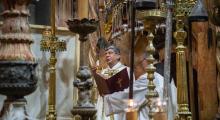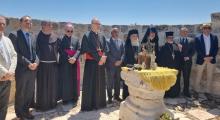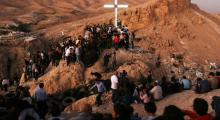Issued by the Catholic Center for Studies and Media - Jordan. Editor-in-chief Fr. Rif'at Bader - موقع أبونا abouna.org

From the Mount of Olives, visitors have a picturesque view of the Old City of Jerusalem. Two thousand years ago, these Instagram-worthy views were likely the last thing on Christ’s mind.
After the last supper, Jesus, accompanied by Peter, James and John, went up the mount to pray. At the entrance, Christ left them, asking them not to fall asleep, which they eventually did.
He wandered through the wide garden of Gethsemane, navigating the dense field of olive trees.
While the hillside was once covered with olive trees, now only a small patch remains, no larger than a school play yard. Visitors follow the footsteps of Christ along pebble paths, walking through what is now a well-manicured garden.
The Agony in the Garden
Enclosed by an iron fence and stone building, the garden looks quite different than it did 2,000 years ago. However, it’s very possible that the garden’s oldest residents — olive trees that are estimated to be about 900 years old — sprouted from the seeds of trees that were around at the time of Christ. Eventually, Jesus stops and finds a rock to pray on.
Gethsemane, in Greek, means olive press, a tool used to apply pressure on olives to release the fragrant, useful oil.
Here, Christ too was placed under extreme pressure. In the garden, he felt the magnitude of the ordeal that he was about to endure, crying out, “My Father, if it is possible, let this cup pass from me; yet not what I want but what you want” (Matthew 26:39). Under this pressure, he began to sweat blood. (Luke 22:44)
Now, a gorgeous basilica covers the rock on which Jesus’ blood fell. The Basilica of the Agony, better known as the Church of all Nations, was constructed in 1919, funded with help from various nations from across the world, including the United States.
Betrayed with a kiss
Entered from the small olive orchard, the apse opens into a large space with high vaulted ceilings.
In front of the ornate marble altar and gold tabernacle lies the rock that Jesus prayed on, encircled by an iron sculpture of thorns. Pilgrims surround the rock, praying and reverencing this sacred spot. Resting on the rock is a perpetual lamp, olive branches and a Franciscan crucifix, designating the spot of Christ’s agony.
Three mosaics decorate the church. The mosaic in the main church shows Christ’s agony. The one set to the left depicts his arrest, and the final mosaic captures his resurrection.
Abruptly, Christ’s prayer ends, as a mob storms past the sleeping apostles and surrounds him.
There Judas Iscariot betrayed his teacher, his friend, with a kiss. Immediately, temple guards grab Christ, forcing him forward.
Angered by what is happening, St. Peter unsheathes his sword, cutting off a guard’s ear. Christ rebukes him and heals the guard’s ear.
Without complaint or hesitation, Christ allows the guards to lead him past the olive trees, down the hill and towards Jerusalem, toward his death.
Now olive trees stand guard as a memorial to that fateful evening when the history of the world changed forever, welcoming pilgrims to the site for prayer and reflection.







